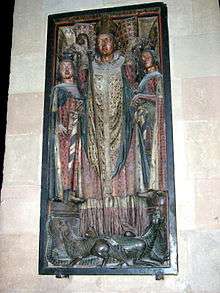Siegfried III (archbishop of Mainz)

Archbishop Siegfried III. of Mainz. The oldest memorial in Mainz Cathedral.[1]
Siegfried III von Eppstein (died 9 March 1249) was Archbishop of Mainz from 1230 to 1249. He in 1244 granted freedom to the citizens of Mainz, who subsequently could run their affairs more independently though their own council;[2][3] in law it remained an episcopal city.[4]
He acted as regent for Conrad IV of Germany, while Emperor Frederick II was campaigning in Italy, 1237 to 1242.[5] He was, though, a supporter of Pope Innocent IV.[6] He ordered the destruction of the then Imperial City of Wiesbaden located just across the Rhine from Mainz in 1242.
He held a major synod in 1239.[7]
He added Lorsch Abbey to the archbishopric.[8]
Notes
- ↑ Kathryn Brush, The tomb slab of archbishop Siegfried III von Eppstein in Mainz cathedral : a thirteenth-century image and its interpretative context in: Grabmäler. Tendenzen der Forschung (2000) p. 33-50
- ↑ John M. Jeep, Medieval Germany: An Encyclopedia (2001), p. 486.
- ↑ Mainz
- ↑ André Vauchez, Richard Barrie Dobson, Michael Lapidge, Encyclopedia of the Middle Ages (2000), p. 892.
- ↑ The New Cambridge Medieval History V, p. 399.
- ↑ Catholic Encyclopedia
- ↑ Paul B. Pixton, The German Episcopacy and the Implementation of the Decrees of the Fourth (1995), p. 418.
- ↑ CATHOLIC ENCYCLOPEDIA: Lorsch Abbey
External links
| Wikimedia Commons has media related to Siegfried III (Archbishop of Mainz). |
- (German) Tombstone
- "Siegfried III". Germania Sacra people index (in German). Göttingen Academy of Sciences and Humanities.
- The city rights privilege for Mainz dated 1244 ("digitalised image". Photograph Archive of Old Original Documents (Lichtbildarchiv älterer Originalurkunden). University of Marburg.)
| Preceded by Siegfried II |
Archbishop of Mainz 1230–1249 |
Succeeded by Christian II |
This article is issued from Wikipedia - version of the 8/27/2016. The text is available under the Creative Commons Attribution/Share Alike but additional terms may apply for the media files.